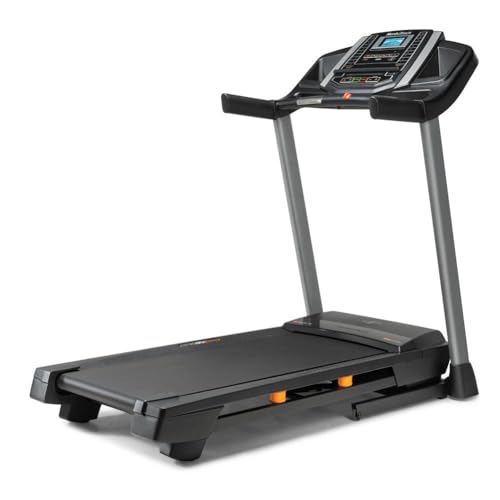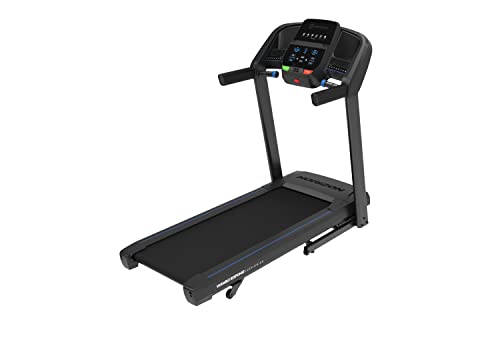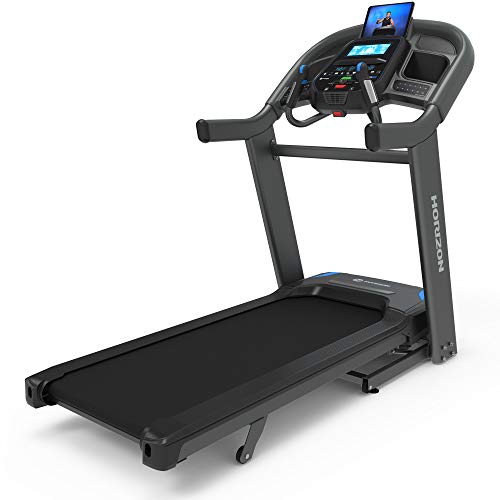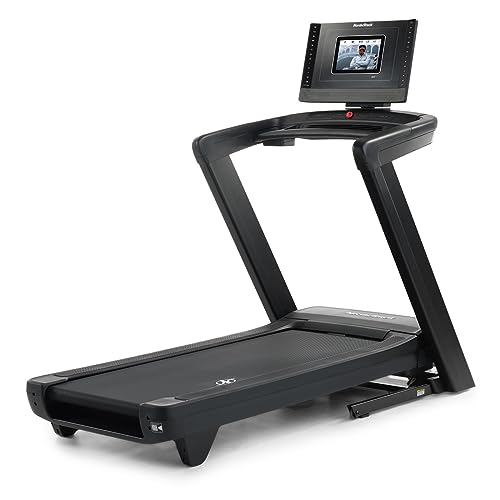What are the different types of cardio equipment and their benefits?
There are several types of cardio equipment available, each with its own unique benefits. Here are some of the most popular options:
-
Treadmills
- Simulate walking or running outdoors
- Adjustable speed and incline settings
- Suitable for all fitness levels
- Easy to use and track progress
- Ideal for weight loss and improving cardiovascular health
-
Elliptical Machines
- Low-impact workout that is easy on the joints
- Engages both upper and lower body
- Adjustable resistance levels
- Suitable for all fitness levels
- Ideal for weight loss, toning, and improving cardiovascular health
-
Stationary Bikes
- Low-impact workout that is easy on the joints
- Adjustable resistance levels
- Suitable for all fitness levels
- Ideal for weight loss, toning legs, and improving cardiovascular health
- Recumbent bikes offer additional back support
-
Rowing Machines
- Full-body workout that engages multiple muscle groups
- Low-impact and easy on the joints
- Adjustable resistance levels
- Ideal for weight loss, toning, and improving cardiovascular health
- Helps improve posture and flexibility
-
Stair Climbers
- Mimics the motion of climbing stairs
- Engages lower body muscles
- Adjustable speed and resistance levels
- Ideal for weight loss, toning legs and glutes, and improving cardiovascular health
-
Jump Ropes
- Portable and affordable
- High-intensity workout that burns calories quickly
- Improves coordination, agility, and footwork
- Ideal for weight loss and improving cardiovascular health
When choosing cardio equipment, consider your fitness goals, current fitness level, any physical limitations, available space, and budget. Incorporating a variety of cardio machines into your workout routine can help prevent boredom and target different muscle groups for optimal results.
How do I choose the right cardio machine for my fitness goals?
Choosing the right cardio machine depends on your specific fitness goals, current fitness level, and any physical limitations you may have. Here's a guide to help you select the best cardio equipment for your needs:
-
Weight Loss
- Treadmills, ellipticals, and rowing machines are excellent for burning calories and promoting weight loss.
- High-intensity interval training (HIIT) on any cardio machine can boost metabolism and maximize calorie burn.
-
Improving Cardiovascular Health
- All cardio machines can help improve heart health when used consistently.
- Treadmills, ellipticals, and stationary bikes are particularly effective for increasing cardiovascular endurance.
-
Low-Impact Workouts (joint-friendly)
- Ellipticals, stationary bikes (especially recumbent bikes), and rowing machines provide low-impact workouts that are easy on the joints.
- These options are suitable for those with joint issues, injuries, or arthritis.
-
Toning and Muscle Building
- Rowing machines and stair climbers engage multiple muscle groups, helping to tone and build strength.
- Ellipticals with moving handles can provide an upper-body workout as well.
-
Convenience and Space
- If you have limited space, consider compact cardio equipment like a folding treadmill or a portable mini stepper.
- Jump ropes are highly portable and can be used anywhere, making them ideal for travel or small spaces.
-
Budget
- Determine your budget before shopping for cardio equipment.
- Treadmills, ellipticals, and stationary bikes are available at various price points to suit different budgets.
- Jump ropes and mini steppers are affordable options for those on a tight budget.
-
Enjoyment and Adherence
- Choose a cardio machine that you enjoy using to increase the likelihood of sticking with your workout routine.
- If you prefer outdoor activities, a treadmill with virtual scenery or an interactive app might be engaging.
- If you enjoy group fitness classes, consider a stationary bike with live or on-demand cycling classes.
Remember, the best cardio machine is the one that you will use consistently. Don't be afraid to try different machines at a gym before investing in home equipment to ensure you make the right choice for your needs and preferences.
What are the best cardio workouts for weight loss?
When it comes to weight loss, the best cardio workouts are those that burn the most calories and keep your metabolism elevated post-workout. Here are some effective cardio workouts for weight loss:
-
High-Intensity Interval Training (HIIT)
- Alternates short bursts of high-intensity exercise with periods of rest or low-intensity recovery
- Can be done on any cardio machine or with bodyweight exercises
- Sample HIIT workout on a treadmill:
- Warm-up: 5 minutes at a moderate pace
- Alternate 30 seconds of sprinting with 1 minute of walking for 10-15 rounds
- Cool-down: 5 minutes at a moderate pace
- Boosts metabolism and continues to burn calories after the workout
-
Steady-State Cardio
- Maintains a consistent, moderate-intensity pace throughout the workout
- Ideal for longer durations (30-60 minutes)
- Examples include jogging, cycling, or swimming at a steady pace
- Promotes fat burning and improves cardiovascular endurance
-
Circuit Training
- Combines cardio and strength training exercises in a circuit format
- Keeps heart rate elevated while building muscle
- Sample circuit workout:
- 30 seconds of jumping jacks
- 30 seconds of bodyweight squats
- 30 seconds of push-ups
- 30 seconds of mountain climbers
- 30 seconds of burpees
- Repeat the circuit for 15-20 minutes
- Helps maintain muscle mass while losing weight
-
Rowing
- Engages multiple muscle groups for a full-body workout
- Burns a significant number of calories
- Provides a low-impact option for those with joint concerns
- Aim for 20-30 minutes of steady rowing or incorporate intervals for added intensity
-
Stair Climbing
- Can be done on a stair climber machine or actual stairs
- Engages lower body muscles and core
- Burns more calories than regular walking
- Aim for 20-30 minutes of continuous stair climbing or perform intervals
Remember, the most effective cardio workout for weight loss is one that you enjoy and can stick with consistently. Aim to incorporate a variety of workouts to prevent boredom and challenge your body in different ways. Combine cardio with a balanced diet and strength training for optimal weight loss results.
How long and how often should I do cardio exercises?
The duration and frequency of your cardio workouts depend on your fitness goals, current fitness level, and schedule. Here are some general guidelines:
-
For general health and wellness:
- Aim for at least 150 minutes of moderate-intensity cardio per week
- This can be broken down into 30-minute sessions, 5 times a week
- Alternatively, you can do 75 minutes of vigorous-intensity cardio per week
-
For weight loss:
- Aim for 300 minutes or more of moderate-intensity cardio per week
- This can be broken down into 60-minute sessions, 5 times a week
- Incorporate high-intensity interval training (HIIT) 1-2 times a week for added calorie burn
-
For improved cardiovascular endurance:
- Gradually increase the duration of your cardio workouts
- Aim for 30-60 minutes of continuous, moderate-intensity cardio per session
- Perform cardio workouts 3-5 times a week
-
For maintaining results:
- Aim for at least 150-300 minutes of moderate-intensity cardio per week
- Incorporate a mix of steady-state cardio and HIIT workouts
- Combine cardio with strength training for a well-rounded fitness routine
Remember to start slowly and gradually increase the duration and intensity of your workouts to avoid injury and burnout. Listen to your body and allow for adequate rest and recovery between sessions. Consult with a healthcare professional or certified fitness trainer to determine the best cardio plan for your individual needs and goals.
Can I do cardio every day or is it better to alternate with strength training?
While it is possible to do cardio every day, it's generally recommended to alternate cardio with strength training for a well-rounded fitness routine. Here's why:
-
Allows for recovery
- Alternating cardio with strength training gives your muscles time to recover and rebuild
- Overtraining can lead to fatigue, decreased performance, and increased risk of injury
-
Prevents boredom and burnout
- Doing the same type of exercise every day can become monotonous
- Varying your workouts helps keep things interesting and engaging
-
Promotes muscle growth and maintenance
- Strength training is essential for building and maintaining muscle mass
- Adequate muscle mass boosts metabolism and aids in fat loss
-
Enhances overall fitness
- Combining cardio and strength training improves multiple aspects of fitness
- Cardio improves cardiovascular health and endurance, while strength training builds muscle, bone density, and functional strength
A sample weekly workout plan might look like this:
| Day | Workout |
|---|---|
| Monday | Cardio (30-60 minutes) |
| Tuesday | Strength training (full body or upper body focus) |
| Wednesday | Rest or light cardio (20-30 minutes) |
| Thursday | Cardio (30-60 minutes) |
| Friday | Strength training (full body or lower body focus) |
| Saturday | Rest or active recovery (yoga, stretching, or light cardio) |
| Sunday | Rest |
If you prefer doing cardio every day, be sure to vary the type, intensity, and duration of your workouts to avoid overuse injuries. Also, incorporate at least 1-2 days of strength training per week to maintain muscle mass and promote overall fitness.
What are some tips for getting the most out of my cardio workouts?
To maximize the effectiveness of your cardio workouts, consider these tips:
-
Warm-up and cool-down
- Begin each session with a 5-10 minute warm-up to gradually increase heart rate and prepare your body for exercise
- End each session with a 5-10 minute cool-down to gradually lower heart rate and prevent dizziness or lightheadedness
-
Vary your workouts
- Incorporate different types of cardio (e.g., running, cycling, swimming) to prevent boredom and target different muscle groups
- Alternate between steady-state cardio and high-intensity interval training (HIIT) to challenge your body in different ways
-
Maintain proper form
- Use proper posture and technique when performing cardio exercises to maximize efficiency and minimize the risk of injury
- If unsure, consult with a certified fitness trainer or watch instructional videos
-
Challenge yourself
- Gradually increase the duration, intensity, or resistance of your workouts to continue making progress
- Aim to push yourself outside of your comfort zone while still maintaining proper form
-
Stay hydrated
- Drink water before, during, and after your cardio workouts to replace fluids lost through sweat
- Proper hydration helps regulate body temperature, transport nutrients, and remove waste products
-
Fuel your body
- Eat a balanced meal or snack containing carbohydrates and protein within 1-2 hours before your workout to provide energy
- Refuel with a protein-rich snack or meal within 30-60 minutes after your workout to support muscle recovery and repair
-
Listen to your body
- Pay attention to how your body feels during and after your workouts
- If you experience pain, dizziness, or excessive fatigue, stop exercising and reassess your approach
- Allow for adequate rest and recovery between workouts to prevent overtraining and injury
-
Use music or entertainment
- Create a motivating playlist or listen to podcasts or audiobooks to make your cardio sessions more enjoyable
- Watch TV or stream videos if using stationary cardio equipment to help pass the time
By incorporating these tips into your cardio routine, you'll be better equipped to stay motivated, prevent injury, and achieve your fitness goals.
How can I stay motivated to stick with my cardio routine?
Staying motivated is key to maintaining a consistent cardio routine. Here are some strategies to help you stay on track:
-
Set SMART goals
- Set Specific, Measurable, Achievable, Relevant, and Time-bound (SMART) goals
- Break down long-term goals into smaller, more manageable milestones
- Celebrate your progress and achievements along the way
-
Find a workout buddy
- Partner with a friend, family member, or colleague who shares similar fitness goals
- Hold each other accountable and provide support and encouragement
- Make your workouts a social activity to look forward to
-
Mix up your routine
- Incorporate variety into your cardio workouts to prevent boredom
- Try new activities, explore different routes, or join a fitness class
- Experiment with different music playlists or audio entertainment
-
Schedule your workouts
- Treat your cardio sessions as important appointments in your calendar
- Plan your workouts for times when you have the most energy and least distractions
- Prepare your workout gear and equipment ahead of time to minimize excuses
-
Track your progress
- Keep a log of your workouts, including duration, intensity, and how you feel
- Use a fitness tracker or smartphone app to monitor your steps, heart rate, and calories burned
- Regularly assess your progress and adjust your goals as needed
-
Reward yourself
- Establish a reward system for reaching milestones or consistently sticking to your routine
- Choose rewards that align with your goals and values, such as new workout gear, a massage, or a healthy treat
- Avoid using food as a reward, as this can undermine your fitness efforts
-
Visualize success
- Imagine yourself achieving your fitness goals and how it will feel
- Create a vision board with images and quotes that inspire and motivate you
- Regularly remind yourself of your reasons for prioritizing your health and well-being
-
Be kind to yourself
- Accept that setbacks and off days are a normal part of the journey
- Don't beat yourself up if you miss a workout or have a less-than-stellar performance
- Focus on progress, not perfection, and celebrate your efforts along the way
Remember, motivation is a skill that can be developed and strengthened over time. By implementing these strategies and finding what works best for you, you'll be better equipped to stay committed to your cardio routine and reap the long-term benefits of a healthy, active lifestyle.
What are some common mistakes people make when using cardio equipment?
To ensure a safe and effective cardio workout, it's important to avoid these common mistakes when using cardio equipment:
-
Skipping the warm-up and cool-down
- Jumping straight into a high-intensity workout without a proper warm-up can lead to injury and decreased performance
- Stopping abruptly after a workout without a cool-down can cause dizziness, lightheadedness, and muscle stiffness
-
Using improper form
- Poor posture and technique can lead to strain, discomfort, and reduced workout efficiency
- Examples include hunching over on a treadmill, leaning heavily on elliptical handles, or bouncing while running
-
Holding onto handrails excessively
- Gripping handrails too tightly or leaning on them excessively can reduce calorie burn and engagement of core muscles
- Only use handrails for balance or support when necessary, focusing on maintaining proper posture
-
Setting the resistance too low or too high
- Using insufficient resistance on stationary bikes, ellipticals, or rowing machines can limit the effectiveness of your workout
- Setting the resistance too high can lead to strain, fatigue, and increased risk of injury
-
Wearing improper footwear
- Wearing shoes that lack proper support, cushioning, or fit can lead to discomfort, blisters, and increased risk of injury
- Choose shoes designed for the specific activity and replace them regularly to ensure optimal support
-
Neglecting to adjust equipment settings
- Failing to adjust the seat height, handlebar position, or other settings can lead to poor form and discomfort
- Take the time to properly adjust the equipment to your body size and preferences
-
Overtraining or doing too much too soon
- Increasing the duration, frequency, or intensity of your workouts too quickly can lead to burnout and injury
- Start slowly and gradually progress, allowing your body time to adapt and recover
-
Ignoring pain or discomfort
- Pushing through pain or ignoring persistent discomfort can exacerbate injuries and lead to long-term issues
- If you experience sharp pain or unusual discomfort, stop your workout and reassess your approach
By being mindful of these common mistakes and taking steps to avoid them, you can ensure a safer, more comfortable, and more effective cardio workout experience.
How do I properly maintain my home cardio equipment?
Regular maintenance of your home cardio equipment is essential for ensuring optimal performance, safety, and longevity. Here are some tips for properly maintaining your cardio machines:
-
Read the owner's manual
- Familiarize yourself with the manufacturer's recommendations for maintenance and care
- Follow the suggested schedule for cleaning, lubricating, and replacing parts
-
Clean the equipment regularly
- Wipe down the machine after each use to remove sweat, dust, and debris
- Use a mild detergent and a soft, damp cloth to avoid damaging the surfaces
- Pay extra attention to high-touch areas like handles, consoles, and seats
-
Lubricate moving parts
- Regularly lubricate any moving parts, such as chains, belts, or pivot points, as directed by the manufacturer
- Use the recommended type and amount of lubricant to prevent damage and ensure smooth operation
-
Tighten and adjust components
- Periodically check and tighten any loose bolts, screws, or other hardware
- Adjust the belt tension, brake pads, or other components as needed to maintain proper function and safety
-
Replace worn or damaged parts
- Inspect your equipment regularly for signs of wear, damage, or malfunction
- Replace any worn or damaged parts, such as belts, decks, or pedals, promptly to prevent further damage or safety hazards
-
Store the equipment properly
- Keep your cardio machines in a cool, dry place away from direct sunlight and moisture
- Cover the equipment when not in use to protect it from dust and debris
- Ensure adequate ventilation to prevent the buildup of heat and moisture
-
Schedule professional maintenance
- Consider having your cardio equipment professionally serviced annually or as recommended by the manufacturer
- A certified technician can perform a thorough inspection, cleaning, and tune-up to keep your machines in top condition
-
Follow usage guidelines
- Adhere to the manufacturer's guidelines for proper use and safety
- Avoid overloading the machine beyond its weight capacity or using it in ways not intended by the manufacturer
By implementing these maintenance practices, you can help ensure that your home cardio equipment remains safe, efficient, and reliable for years to come. Regular care and attention can also help you avoid costly repairs or replacements down the line.
What are some affordable cardio equipment options for a home gym?
When building a home gym on a budget, there are several affordable cardio equipment options to consider:
-
Jump Rope
- Highly portable and compact
- Inexpensive, with many options under $20
- Provides a high-intensity cardio workout
- Improves coordination and agility
-
Resistance Bands
- Versatile and lightweight
- Can be used for strength training and cardio exercises
- Resistance bands sets are often priced under $50
- Easy to store and travel with
-
Steppers
- Compact and affordable, with many options under $100
- Provides a low-impact cardio workout
- Engages lower body muscles
- Can be stored easily when not in use
-
Foldable Exercise Bikes
- More compact than traditional stationary bikes
- Many options available for under $200
- Provides a low-impact cardio workout
- Can be folded and stored when not in use
-
Doorway Pull-Up Bar
- Inexpensive, with many options under $50
- Provides an upper body workout and engages core muscles
- Can be used for cardio exercises like pull-ups and leg raises
- Easy to install and remove without damaging doors
-
Kettlebells
- Compact and versatile
- Can be used for strength training and cardio exercises
- Prices vary based on weight, but many options are available for under $50
- Takes up minimal storage space
-
Plyo Box
- Can be used for plyometric exercises and step-ups
- Many options available for under $100
- Provides a high-intensity cardio workout
- Can be used for other exercises like dips and push-ups
-
Medicine Ball
- Versatile and compact
- Can be used for strength training and cardio exercises
- Many options available for under $50
- Easy to store when not in use
When choosing affordable cardio equipment for your home gym, consider your available space, fitness goals, and personal preferences. By incorporating a variety of budget-friendly options, you can create a well-rounded cardio routine without breaking the bank




